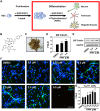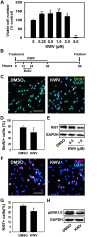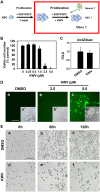Kuwanon V inhibits proliferation, promotes cell survival and increases neurogenesis of neural stem cells
- PMID: 25706719
- PMCID: PMC4338147
- DOI: 10.1371/journal.pone.0118188
Kuwanon V inhibits proliferation, promotes cell survival and increases neurogenesis of neural stem cells
Abstract
Neural stem cells (NSCs) have the ability to proliferate and differentiate into neurons and glia. Regulation of NSC fate by small molecules is important for the generation of a certain type of cell. The identification of small molecules that can induce new neurons from NSCs could facilitate regenerative medicine and drug development for neurodegenerative diseases. In this study, we screened natural compounds to identify molecules that are effective on NSC cell fate determination. We found that Kuwanon V (KWV), which was isolated from the mulberry tree (Morus bombycis) root, increased neurogenesis in rat NSCs. In addition, during NSC differentiation, KWV increased cell survival and inhibited cell proliferation as shown by 5-bromo-2-deoxyuridine pulse experiments, Ki67 immunostaining and neurosphere forming assays. Interestingly, KWV enhanced neuronal differentiation and decreased NSC proliferation even in the presence of mitogens such as epidermal growth factor and fibroblast growth factor 2. KWV treatment of NSCs reduced the phosphorylation of extracellular signal-regulated kinase 1/2, increased mRNA expression levels of the cyclin-dependent kinase inhibitor p21, down-regulated Notch/Hairy expression levels and up-regulated microRNA miR-9, miR-29a and miR-181a. Taken together, our data suggest that KWV modulates NSC fate to induce neurogenesis, and it may be considered as a new drug candidate that can regenerate or protect neurons in neurodegenerative diseases.
Conflict of interest statement
Figures






Similar articles
-
Differential effects of MEK inhibitors on rat neural stem cell differentiation: Repressive roles of MEK2 in neurogenesis and induction of astrocytogenesis by PD98059.Pharmacol Res. 2019 Nov;149:104466. doi: 10.1016/j.phrs.2019.104466. Epub 2019 Sep 25. Pharmacol Res. 2019. PMID: 31562895
-
Astragaloside VI Promotes Neural Stem Cell Proliferation and Enhances Neurological Function Recovery in Transient Cerebral Ischemic Injury via Activating EGFR/MAPK Signaling Cascades.Mol Neurobiol. 2019 Apr;56(4):3053-3067. doi: 10.1007/s12035-018-1294-3. Epub 2018 Aug 7. Mol Neurobiol. 2019. PMID: 30088176
-
Propofol Inhibits Neurogenesis of Rat Neural Stem Cells by Upregulating MicroRNA-141-3p.Stem Cells Dev. 2017 Feb 1;26(3):189-196. doi: 10.1089/scd.2016.0257. Epub 2016 Oct 27. Stem Cells Dev. 2017. PMID: 27796156
-
[Thyroid hormones regulate neural stem cell fate].Biol Aujourdhui. 2019;213(1-2):7-16. doi: 10.1051/jbio/2019007. Epub 2019 Jul 5. Biol Aujourdhui. 2019. PMID: 31274098 Review. French.
-
Neural stem cell differentiation into mature neurons: Mechanisms of regulation and biotechnological applications.Biotechnol Adv. 2018 Nov 15;36(7):1946-1970. doi: 10.1016/j.biotechadv.2018.08.002. Epub 2018 Aug 3. Biotechnol Adv. 2018. PMID: 30077716 Review.
Cited by
-
Mulberry Diels-Alder-type adducts: isolation, structure, bioactivity, and synthesis.Nat Prod Bioprospect. 2022 Sep 2;12(1):31. doi: 10.1007/s13659-022-00355-y. Nat Prod Bioprospect. 2022. PMID: 36050566 Free PMC article. Review.
-
Signaling involved in stem cell reprogramming and differentiation.World J Stem Cells. 2015 Aug 26;7(7):992-8. doi: 10.4252/wjsc.v7.i7.992. World J Stem Cells. 2015. PMID: 26328015 Free PMC article.
-
Proteasome Inhibitor MG132 is Toxic and Inhibits the Proliferation of Rat Neural Stem Cells but Increases BDNF Expression to Protect Neurons.Biomolecules. 2020 Nov 2;10(11):1507. doi: 10.3390/biom10111507. Biomolecules. 2020. PMID: 33147870 Free PMC article.
-
A genetically immortalized human stem cell line: a promising new tool for Alzheimer's disease therapy.EXCLI J. 2015 Oct 21;14:1135-14. doi: 10.17179/excli2015-560. eCollection 2015. EXCLI J. 2015. PMID: 27152108 Free PMC article.
-
An Aminopropyl Carbazole Derivative Induces Neurogenesis by Increasing Final Cell Division in Neural Stem Cells.Biomol Ther (Seoul). 2015 Jul;23(4):313-9. doi: 10.4062/biomolther.2015.016. Epub 2015 Jul 1. Biomol Ther (Seoul). 2015. PMID: 26157546 Free PMC article.
References
-
- Gage FH (2000) Mammalian neural stem cells. Science 287: 1433–1438. - PubMed
-
- McKay R (1997) Stem cells in the central nervous system. Science 276: 66–71. - PubMed
-
- Wright LS, Prowse KR, Wallace K, Linskens MH, Svendsen CN (2006) Human progenitor cells isolated from the developing cortex undergo decreased neurogenesis and eventual senescence following expansion in vitro. Exp Cell Res 312: 2107–2120. - PubMed
-
- Rosser AE, Tyers P, ter Borg M, Dunnett SB, Svendsen CN (1997) Co-expression of MAP-2 and GFAP in cells developing from rat EGF responsive precursor cells. Brain Res Dev Brain Res 98: 291–295. - PubMed
-
- Longo FM, Yang T, Xie Y, Massa SM (2006) Small molecule approaches for promoting neurogenesis. Curr Alzheimer Res 3: 5–10. - PubMed
Publication types
MeSH terms
Substances
LinkOut - more resources
Full Text Sources
Other Literature Sources

